Soccer drills
- Pass and dribble
- Player follows the ball
- Pass correctly and pay attention to 1 x hit
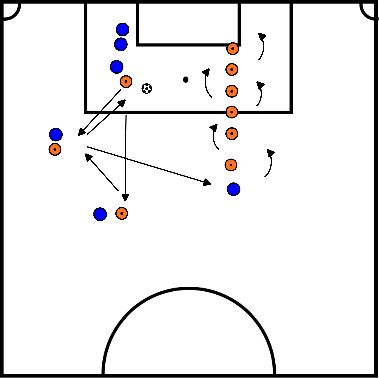
Description:
- Position play, where the overtal must put immediate pressure on ball loss
- Position play, where the overtal must put immediate pressure on ball loss
Game Shape:
- The red team plays the ball around or plays for possession.
- The blue team tries to take the ball away.
- If the blue team has gained possession of the ball, they must try to score as soon as possible in 1 of the 4 goals.
- The red team must prevent this from happening.
- We play 9 x 5.
Dimensions:
- 40x40
- 40x40
Coaching:
- Is it pressured at all when the ball is lost?
- If yes, by whom and by whom not? If no, why not?
- If pressure is applied, how? Aggressively from the idea of capturing the ball immediately or from a shuffling pace?

Description
- Players start at pylons
- Balls are in the middle
- Players kick in place
- When trainer calls, players go toward balls, 2-pairs at 1 ball
- Coach calls left and right, players go to that side
- When trainer calls ball, you have to take the ball with your hands
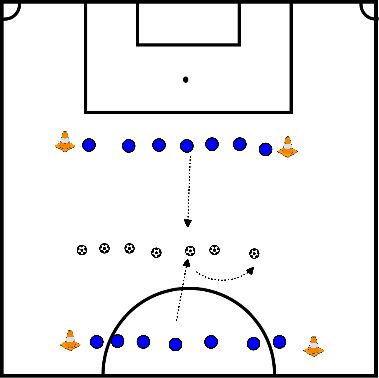
- Distance about 10 meters
- Walking exercise: first easy walking pace 3x
- Have players stand side by side in place;
- have leg lifted at hip height and arm forward so the finger comes up to shoulder height.
- Then walk at pace,
- have leg lifted to hip height and arm forward so finger comes up to shoulder height.
- If right leg goes up then left arm should also go up. The rest of the body remains still. 10x at a slow pace.
- Then accelerate 10x while ensuring that the player performs the exercise correctly technically as described above.

This Exercise can be performed on both sides:
- Good handball
- Tight pass after it
- Lay wide edge 16
- After this round off on goal.
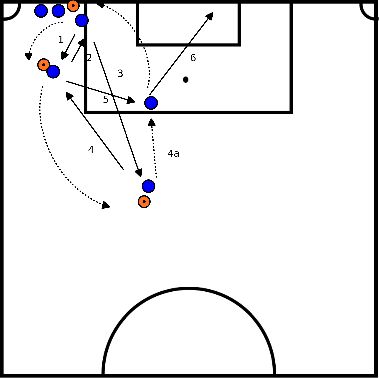
1st exercise:
- Player A plays the ball in to B and runs to B's position.
- Player B stands open turned, takes it and passes it to Player C and so on.
- Point of attention playing in:
- the ball must be hit in the middle so that it stays low.
- The correct technique for this is to lift your shooting leg slightly.
- Passing point:
- The player who accepts the ball should not be facing the ball with his or her body, but turned "open". You create this by positioning your body towards the player you are passing to and with your eyes on the ball.
- Playing around clockwise, the ball is taken on with the left and I play on with the right.
- In the other direction take on with the right and play on with the left.
- If you notice it's too easy, first increase the pace. Then to make it more difficult you can take out the assumption and they have to pass the ball directly.
2nd exercise:
- Player B asks for the ball.
- Player A plays into player B.
- Then B then drops the ball to player A after which he passes it back to player C.
- Player C then drops it to player B and then player B plays it diagonally to player D and so on.
Points of attention:
- The player who plays the ball in must move on after the play-in so that he can ask for the ball, in the middle, between the pawns
- Not further because then the effect is gone with the cross pass.
- The player who rebounds runs around his own pawn to ask for the ball again in the middle.
- This player must make the correct turn when rebounding so that he keeps his eyes on the ball.
- His turn should be short toward the box and not off the play.
In both drills after 8 minutes, change directions of play.
Clockwise passes with right leg, counterclockwise passes with left leg.
Clockwise passes with right leg, counterclockwise passes with left leg.
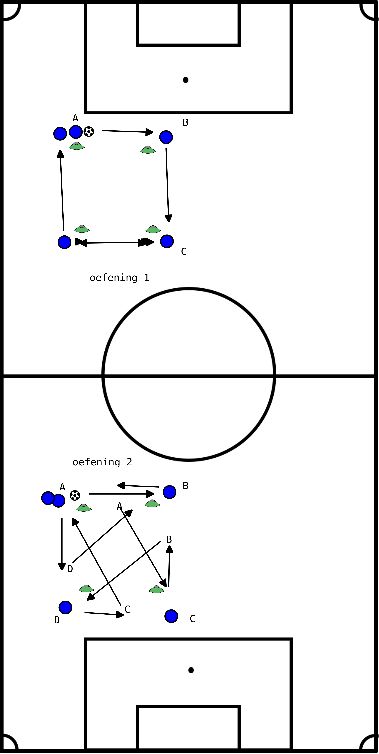
1st exercise:
- Player A plays the ball in to B and runs to B's position.
- Player B is open turned takes it and passes it to Player C and so on.
- Focal point 1 playing in: the ball must be hit in the middle so that it stays low.
- The correct technique for this is to lift your shooting leg slightly.
- Focal point 2 receiving: The player who has to receive the ball should not be facing the ball but rather, as they say, turned open. You create this by positioning your body towards the player you have to pass to and your face is facing the ball. Playing the ball around clockwise, the ball is taken on with the left and I play on with the right. other way round take on with the right and play on with the left.
- If you notice that it is too easy, first increase the tempo. If that also proves too easy then you take out the takeover and they have to pass the ball directly.
2nd exercise:
- Player B asks for the ball, player A plays into player B. Then B drops the ball to player A who then passes it on to player C.
- Player C then drops it to player B and then player B plays it diagonally to player D and so on.
Points of attention:
- The player who plays the ball in must move on after playing in so that he asks for the ball in the middle between the pawns
- Not further because then the cross pass effect is gone.
- The player who bounces the ball back runs around his own pawn to ask for the ball again in the middle.
- It is imperative that this player makes the correct turn when rebounding so that he keeps his eyes on the ball.
- His turn should be short toward the box and not off the play.

This exercise is a brief warm up at the top for the youngest groups and in the circle for the upper level teams.
- In passes with right and left
- Head strike on the chest or upper leg
- Passing back

- Taking a corner kick
- play to 1st running
- put block
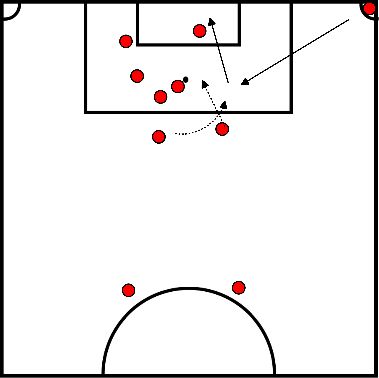
- Corner take variant 3
- High ball towards the 2nd post
- Heading back in front of goal
- 3 men running in
- Tuck in
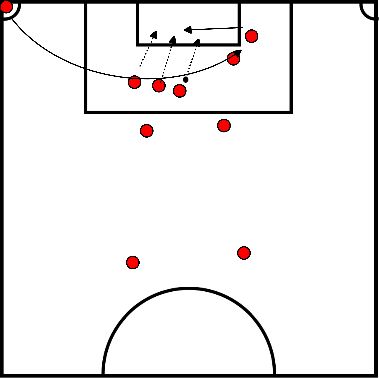
- Corner take variant 3
- High ball towards the 2nd post
- Heading back in front of goal
- 3 men running in
- Tuck in
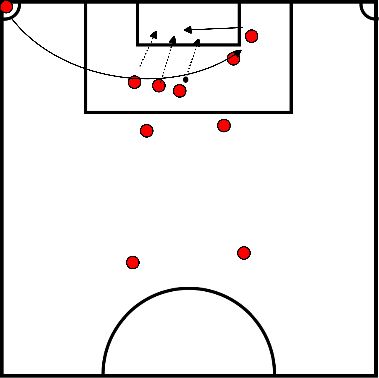
- Corner kick take variant 2









